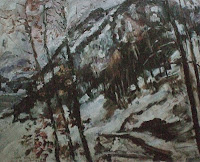The next weekend also found me walking among the trees, but these trees were on canvasses painted by Max Liebermann, Lovis Corinth and Max Slevogt. I felt a tingle of inspiration. These artists had the same desire to celebrate nature. Wait, maybe that is not quite correct. Karen Wilkin in a review in The Wall Street Journal (30 November 2010)writes: "...in the German works, French-type enthusiasm for the appearances of landscape seems charged here with a mystical desire to be 'one with nature,' a phenomenon that anyone with German friends will recognize as still current." That explains a lot!
As I took in the exhibit (actually, two: "German Impressionist Landscape Painting" and "Drawing from Nature: Landscapes by Liebermann, Corinth and Slevogt") I was besotted. This is how I want to paint! Freedom. Yet firmly grounded in the given world. Sounds like contentment...
One painting in particular grabbed my attention: Red Arbor with Dog, an earlier painting by Max Slevogt. It is a dark and moody image that draws you right in. I thought about what I could paint that would give a similar feeling and thought of the fence rows of blackberry bushes near my studio. I could have even included a dog, since little Luke often accompanies me on walks out at the lake! (But, I did not...) Below is my painting, Red Fence Row.
What struck me most about Lovis Corinth was his ability to so convincingly depict the steep slopes of his Alpine setting (later in his life he painted at Walchensee in Upper Bavaria). So, it was very interesting to learn that a stroke that afflicted him at the age of 53, affected his spacial perception. Most of Corinth's landscape works were painted after his stroke. Below is his painting, The Herzogstand at Walchensee in the Snow. In my painting Dancing Landscape, I tried to convey the same sense of slope.
Viewing this exhibit, there was an overall feeling of liberation. Here is how Karen Wilkin of The Wall Street Journal describes the Liebermann, Corinth, Slevogt paintings: "All three artists' paintings are direct and bold, as if the painterly tradition of Hals and Rubens had been co-opted for other purposes. All three revel in manipulating paint, suppressing details in favor of virtuoso mark-making. Slashing brush-strokes and rapid scribbles.." It is the "at oneness" with the landscape that enraptures this artist.
There is an excellent catalogue from the exhibit: German Impressionist Landscape Painting Liebermann-Corinth-Slevogt, edited by Gotz Czymmek and Helga Kessler Aurisch, Arnoldsche Art Publishers









